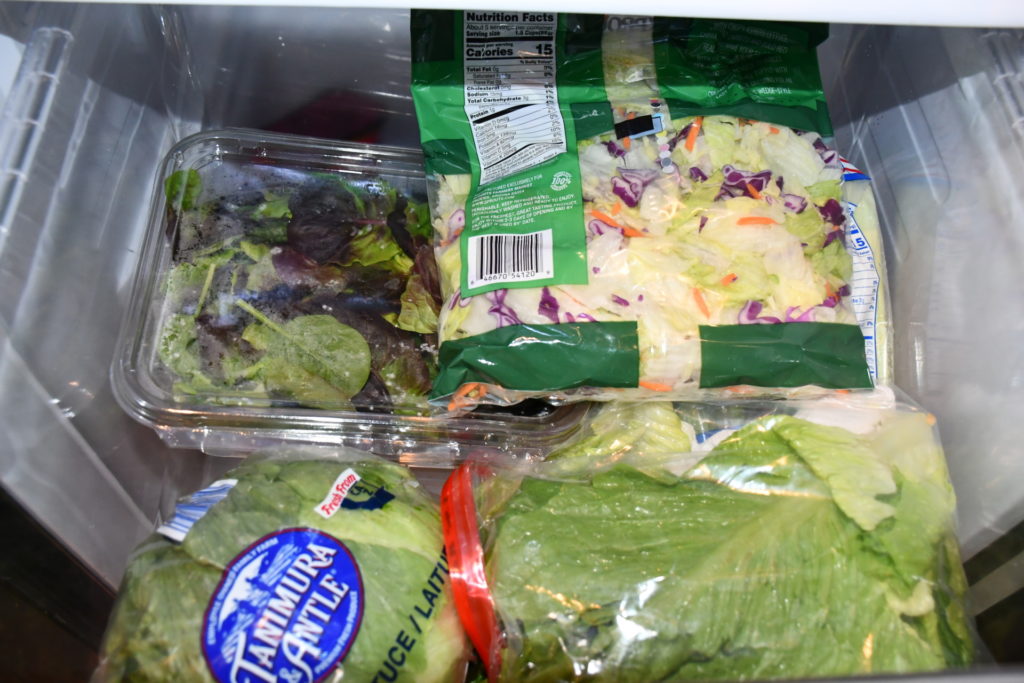How to keep salad greens greener, longer
Tips for extending life, crispness of salad greens
Salad greens are among the most perishable produce items, and keeping them crisp and fresh until consumed can be a challenge, said a Texas A&M AgriLife Extension Service expert.
“Salad greens are delicate and have a relatively short lifespan, and it takes some effort to keep them crisp and attractive,” said Rebecca Dittmar, AgriLife Extension program specialist in nutrition, Kerrville.
Spend your green on good greens
Dittmar said it is important to purchase the freshest possible greens from a trusted location.
Dittmar said once greens are purchased, they should be brought home as quickly as possible and put into the refrigerator.
“Buying high-quality produce from a reliable vendor or grocery store not only helps ensure you are getting the freshest possible product, it also helps ensure you are getting the maximum nutritional benefit from that product and are better protected from the possibility of foodborne illness,” she said.
She said for maximum crispness, it’s usually best not to wash the greens until you are ready to use them.
Dittmar said in her experience, the best method of preserving greens is to place them in a perforated or regular plastic bag or hard-sided container, then store them in the refrigerator crisper.
“If you have a salad spinner and plan to use the greens soon, you can clean them, spin off any excess moisture, then cover the spinner and place in the crisper for storage,” she said.
She noted placing the greens in a plastic container or other hard-sided box also provides the added benefit of protecting the greens from being crushed or bruised by other foods in the same area.
Dittmar said while some recommend wrapping washed and dried salad greens in a moist paper towel before putting them into a plastic bag or container, too much moisture can be a problem.

“The concern with wrapping the greens or lining the bag or container with a moist paper towel is that introducing moisture in the bag could promote spoilage or pathogenic growth,” she said. “However, once it is rinsed and patted dry with paper towels, storing the greens in a bag or plastic container lined with dry paper towels to soak up any extra moisture should be fine.”
Dittmar said, generally speaking, it’s possible to keep most salad greens fresh for at least a week if you buy them at peak freshness and take the proper steps for storing them in your refrigerator.
When preparing greens, whether peeling the leaves from a head of iceberg lettuce or chopping up arugula or romaine, wash the produce under cold running tap water to remove any lingering dirt. This also reduces the presence of any bacteria that may be present.
“Both the U.S. Department of Agriculture and the Food and Drug Administration recommend washing produce under cold running water to get the best results,” she said.
Consumers should not wash produce with detergent or soap, Dittmar added.
“Once rinsed, gently shake or agitate the leaves and thoroughly pat them dry between paper towels or spin-dry them in a salad spinner.”
Different means for different greens
“It is not recommended to rewash produce that is prewashed and packaged,” Dittmar said. “At the store, you may find produce like bagged salads labeled ‘pre-washed’ or ‘ready-to-eat.’ If you see this label, then you can safely use the produce without further washing.”

However, she said, if consumers do choose rewash produce already marked as such, be sure it does not come in contact with unclean surfaces or utensils, especially those that have touched raw meat, poultry or seafood or their juices. This will help to avoid cross-contamination.
Here are some other tips on storing different salad greens:
- Whole heads of iceberg, romaine, bibb and other lettuce will stay fresher longer than leaves or chopped pieces. Heads of raw lettuce should be kept intact and left unwashed until ready to use. For romaine and bibb, remove any damaged or wilted outer leaves, place in a plastic bag or container and store in the crisper. For iceberg lettuce, keep the whole head wrapped in its original packaging and place in the crisper drawer until ready to consume.
- Loose-leaf lettuce such as spinach or arugula are typically pre-washed and sorted, but still pick through the lettuce to remove any damaged leaves. Line a sturdy glass or plastic container with a few dry paper towels, then scatter your greens on top and cover with a lid. Leave some room for the air to circulate. If no container is available, use a plastic bag, but leave a small portion of it open so air can circulate.
- Kale is best if eaten soon after purchase, but it should keep for up to a week in the refrigerator. Store kale unwashed with leaves close together and wrap them in dry paper towels, then place in a perforated plastic bag or plastic container and put in the crisper.
- Spinach, Swiss chard and collard or turnip greens should all be stored in a plastic bag or container in the refrigerator crisper. These greens usually stay crisp for four days or longer if properly stored.
- For kohlrabi, cut off the greens and wrap in a dry paper towel and place in a perforated plastic bag or plastic container and store in the crisper. Kohlrabi leaves are among the most perishable of greens and will only remain crisp for two to three days. However, kohlrabi bulbs can last for up to two weeks if stored loosely in the crisper drawer of the refrigerator.



